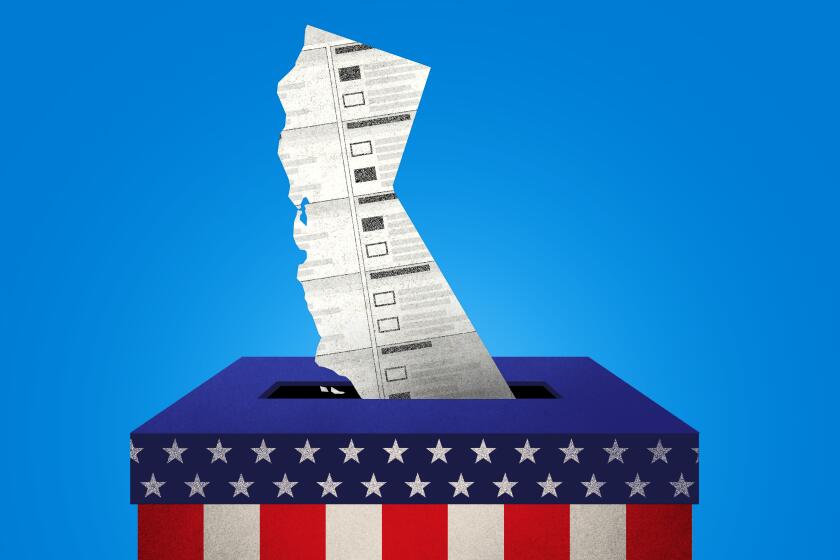Column: Cool weather, hot races forecast for November

- Share via
- Seven states will decide the presidential contest. A single electoral vote in Nebraska could also matter.
- The fight for control of Congress is a toss-up, though Republicans have an edge in the fight for the Senate.
Today we discuss cliff-hangers, the Founding Fathers and legerdemain.
Let’s get to it. Who’s going to win the presidential race?
I haven’t a clue.
So what good are you?
That’s a question readers ask all the time.
What can you say about the race?
The contest will come down to seven or so highly competitive states and, maybe, the one electoral vote in Nebraska’s 2nd Congressional District, which is anchored in the Omaha-Council Bluffs metropolitan area.
The key states are Arizona, Georgia, Michigan, Nevada, North Carolina, Pennsylvania and Wisconsin. In short, the battlegrounds that determined the outcome of the 2020 election.
Why the same states over and over? Why not, say, California?
Pull up your chair for a quick civics refresher.
The presidential race is determined not by the winner of the popular vote but which candidate takes a majority — 270 votes — in the electoral college. Some might recollect that two of our last four presidents — George W. Bush and Donald Trump — claimed the White House despite losing the popular vote.
Like the rest of the nation, voters on the Olympic Peninsula of Washington appear evenly split between the two. Many in Clallam County — the last presidential bellwether county in America — can’t fathom how anyone thinks differently.
That’s outrageous!
Can’t help you there. Blame the country’s founders. They wrote the rule book.
Go on.
Most states, including the biggies like California, Texas, Florida and New York, are locked into their partisan preferences. (California and New York are solidly Democratic while Texas and Florida — once the nation’s premier swing state — lean Republican.)
Given those inclinations, Kamala Harris can pretty much bank on 226 electoral votes. Trump can count on 219. That leaves 93 up for grabs in those seven states.
What was that about Omaha?
Just about every state awards their electoral votes on a winner-take-all basis. Nebraska is one of two — Maine being the other — that has a hybrid system awarding some electoral votes to the winner of the statewide vote and others based on the winner of each congressional district.
There’s a not-inconceivable scenario in which Harris finishes with 269 electoral votes and needs the one vote from Nebraska to avoid a tie in the electoral college, which would send the election to the House to decide. In that case, Trump would almost certainly prevail, as each state’s delegation would have one vote and Republicans are expected to control more delegations than Democrats.
Wasn’t there a recent effort to boost Trump by changing the law in Nebraska?
Yes there was and it failed, thanks to a single upstanding Republican state senator from Omaha, Mike McDonnell, who refused to go along.
Which was a good thing.
Why is that?
If you thought 2020 was fraught — with all the wrangling over pandemic-induced changes to the balloting process — or consider the 2000 contest to have been divisive — with a partisan Supreme Court vote delivering the White House to George W. Bush after Florida effectively ended in a tie vote — imagine if this election was decided by some last-minute Republican sleight of hand.
What about control of Congress?
That also appears up for grabs, though Republicans have a distinct advantage in the fight for the Senate.
Schwarzenegger unexpectedly sprang forth and launched a 60-day candidacy for governor as part of a madcap recall election. There are noteworthy parallels between that contest and the truncated race for president.
Because of that French word you used?
Legerdemain? No. Because of mathematics.
There are 34 Senate races across the country. Democrats are defending 23 seats, Republicans 11. Worse for Democrats, several of the seats they’re trying to hang onto are in states Trump carried in 2020 — several of them rather handily.
Right now, Democrats hold a bare Senate 51-49 majority, which includes four independents who caucus with them. The party has ceded West Virginia, where one of those independents, Joe Manchin III, is retiring and where Trump won by nearly 40 percentage points in 2020. That puts the Senate at 50-50. Democrats could keep control if they win the White House, since the vice president casts the tie-breaking vote. But that would require the party to win every one of the seats now being fiercely contested.
And how’s that going for Democrats?
Not bad — but maybe not good enough.
At the moment, Democrats appear to be holding their own in Arizona, Nevada and Pennsylvania. But Michigan, Ohio and Wisconsin look to be much closer. And Democrat Jon Tester appears to be in grave danger in Montana, a state Trump carried four years ago by 16 percentage points. Tester has a history of winning tough races, but this one is his toughest yet.
So it’s all gravy for Republicans?
Pretty much.
Democrats would love to flip GOP-held seats in Texas and Florida and help take out Sen. Deb Fischer in Nebraska, where independent Dan Osborn is making a strong run.
But all three states are virtually certain to back Trump in November and it’s getting increasingly difficult for Senate candidates to swim against the partisan tide. In 2016, for the first time since the direct election of U.S. senators began a century earlier, every Senate race went the same way as the presidential contest; if Trump won a state, the seat went Republican. If Hillary Clinton prevailed, the seat went Democratic.
That pattern held in 2020 with the exception of Maine, where Joe Biden prevailed and Republican Susan Collins was reelected to her fifth term.
What about control of the House?
That’s also too close to call.
Republicans currently hold a razor-wafer-tissue-thin (your choice!) majority of just four seats. All 435 seats are on November’s ballot, but the fight for the majority will come down to roughly two dozen contests.
Several of those are in California, which has become one of the country’s prime congressional battlegrounds after voters in 2008 took the power to draw district lines away from self-interested lawmakers. Democrats hope to flip Republican-held seats in Orange County, the Central Valley, the L.A. suburbs and Palm Springs. They’re also on the offense in New York, where the GOP made significant gains in the 2022 midterm election.
Voting in California’s general election continues through election day, Nov. 5. Read up on the races in L.A. city and L.A. County, the California statewide ballot propositions and other measures.
But Republicans aren’t just hunkered down trying to preserve their bare majority. GOP targets include a handful of Democratic-held seats in California as well as incumbents in Colorado, New Mexico, Ohio, Pennsylvania and elsewhere.
What do the polls say?
Ignore ‘em. Even the best are nothing more than an educated guess. No one knows what’s going to happen.
Honest.
Instead of obsessing over the latest higgledy-piggledy, do something useful. If you’re undecided, do some research. If you’re committed to a candidate, and have the time and inclination, volunteer to knock on doors or make phone calls.
Above all, be sure to vote and do so in time to make certain your ballot is counted.
More to Read
Get the latest from Mark Z. Barabak
Focusing on politics out West, from the Golden Gate to the U.S. Capitol.
You may occasionally receive promotional content from the Los Angeles Times.














